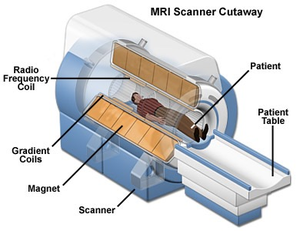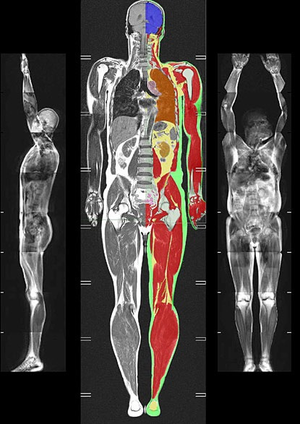MAGNETIC RESONANCE IMAGING (MRI)
- Previous chapter: 6.6 POSITRON EMISSION TOMOGRAPHY (PET)
Magnetic resonance imaging (MRI) is an imaging technique used primarily in healthcare to visualize internal organs of the human body. With an MRI it is possible to obtain slices of certain areas of the body. Magnetic resonance imaging uses a large magnetic field and electromagnetic waves with high frequency. Unlike CT, which is sometimes an alternative to MR, it has no risks caused by radiation (radiation zero load). The disadvantage of the MR examination is the noise.
The Physical principle of magnetic resonance imaging (MRI) is a nuclear magnetic resonance (NMR). It uses the fact that protons as well as neutrons have a proper torque spin which makes the whole nucleus to acquire a magnetic moment.
MRI machines make use of the fact that body tissue contains a lot of water, and hence protons (1H nuclei), which get aligned in a large magnetic field. Each water molecule has two hydrogen nuclei or protons. When a person is inside the powerful magnetic field of the scanner, the average magnetic moment of many protons becomes aligned with the direction of the field. A radio frequency current is briefly turned on, producing a varying electromagnetic field. This electromagnetic field has just the right frequency, known as the resonance frequency, to be absorbed and to flip the spin of the protons in the magnetic field. After the electromagnetic field is turned off, the spins of the protons return to thermodynamic equilibrium and the bulk magnetization becomes re-aligned with the static magnetic field. During this relaxation, a radio frequency signal (electromagnetic radiation in the RF range) is generated, which can be measured with receiver coils.
Protons in different tissues return to their equilibrium state at different relaxation rates. Different tissue variables, including spin density, T1 and T2 relaxation times, and flow and spectral shifts can be used to construct images. By changing the settings on the scanner, this effect is used to create a contrast between different types of body tissue or between other properties, as for example in fMRI and diffusion MRI.
On the basis of the measured induced voltage and other parameters of the signal by complex processes and algorithms converted to gray scale. (Just because the resulting signal is dependent on many parameters, can not be used any scale that would precisely identify the various tissues, hence the interpretation of the images used more interfaces which changes the signal intensity.)
The received signal is dependent on many parameters and therefore the identification of body tissues can not be made solely depending on the grey scale.
Links[edit | edit source]
Next chapter: 7. THERAPEUTIC METHODS
Back to Contents


